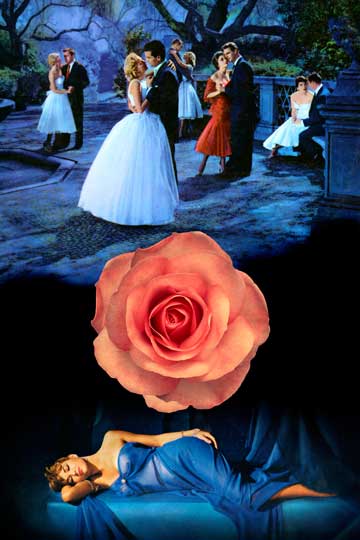
Columbus, Ohio USA
Return to Homepage www.shortnorth.com
Darkness Into Light
Capturing the chiaroscuro of the human soul
Review: Rivet Gallery
February 2009
by Kaizaad Kotwal
kaizaadkotwal@yahoo.com
Visit Kotwal Archive
Return to Homepage© Photos Courtesy of Rivet Gallery
A series of works, labeled by the Rivet Gallery as “underground photographs,” make for compelling viewing. Gallery owner Laura Kuenzli came up with the term “underground” to subtitle the exhibit “Darkness Into Light” because, as she said, “the images are provocative.”
Dreamy, by Chas Ray Krider
Seven artists in all are featured here – each with his or her own take on what classifies as “underground” art.
Local artist Chas Ray Krider’s photographs have the lush veneer of marketing ads – glossy and perfectly rendered. His collages seem benign on the surface. Yet, look closely, and the darker, even funny subtext begins to seep through.
In Fleurs du Mal, possibly inspired by Charles Baudelaire’s volume of poetry of the same name, a series of blooming flowers fills the flattened plane of the montage. The pastel tones – pinks, greens and blues – are nicely contradicted by a skull lurking behind a few flowers. But whatever danger lurks therein is dissipated by the daffy grin the skull wears.
Dreamy plays with the Freudian maxim that sometimes a cigar is not just a cigar. Krider once again creates a collage that oozes romanticism. In this triptych of sorts a woman in a blue gown lies on a pedestal. The drape behind her is actually the same fabric that morphs into her dress. As our eye travels upwards a large red rose in full bloom occupies the focal point.
The top of Dreamy features five couples dancing outdoors. Dressed in their 1950s best, Krider’s work reverberates with myths of that era – outward perfection, sexual repression, perfect marriages. The one woman dressed in red, with all the others in white, raise many questions about the story being told.
Krider’s work is replete with visual sexual double-entendres. Freudian or even Jungian apostles would have a field day dissecting the image, uncovering layer upon layer of meaning pertaining to human sexuality and behavior.
John Santerineross’s heavily staged photographs are also replete with symbolism, much of it pertaining to female sexuality as viewed through the male lens.
Both X and The Te, are color photos bleached of most of the pigment. The carefully manipulated sepia-tinted works feature highlights of red and pink in the women’s makeup.
While not actually disfigured, the way Santerineross captures his female subjects they often seem somewhat disembodied; their limbs, while whole, seem decapitated or stunted. A closer look reveals otherwise.
It is apparent that Santerineross composes his works very carefully, surrounding his models with found objects. These staged photographs are compelling and disturbing in both what they reveal and what they keep hidden or ambiguous. There is in his images a lot about male fantasies surrounding women – passivity, coyness, submissiveness. Yet, whether Santerineross is deconstructing such archaic notions or celebrating them remains unclear.
Untitled work by Robyn Von Swank
Santerineross uses very little digital manipulation, probably one of the most shocking aspects of this show, in an age when traditional photography is gradually waning. He also only makes about twelve photographs a year because each is so complex in its construction of the overall mise-en-scène.
Two untitled photographs by Robyn Von Swank are wonderful works with detailed nuance in the way lighting captures tone and texture. The chiaroscuro in both is dazzling as the play of light and shadow adds to the mystery of the image.
Done as traditional portraiture, these monochromatic works feature men in costumes that seem gothic or medieval in their resonances. Both subjects stare directly at us, and this confrontational gaze makes us feel diminished in our power.
This is a strong exhibit featuring artists committed to their craft and creating art that is not necessarily mainstream. Yet, the label “underground photography” seems baffling. An extensive search for origins of that term suggests there is no such formalized movement in the history of photography. This is my only quibble with the exhibit and a cautionary note: Ultimately, the issue isn’t whether their art may be shocking to some or maybe to many as the term suggests, but rather where these images fit within the history and trajectory of photography. In that sense there is nothing underground, taboo or so shocking here that a new term needs to be coined. To artificially place these works as so subversive that they need to be labeled as “underground” negates the pioneering work that has come before – art that was truly taboo and first in its attempts to shake up the status quo.
The artists in this exhibit are not pioneers per se, but rather accomplished inheritors, descendants of a long tradition of art and photography that makes their work possible. These are photographs that may take on some taboo issues, but what unifies them is their aesthetic inventiveness and technical proficiency. All the artists also have a penchant for the dramatic – from the characters they create to the stages they concoct, this is a show of high-jinx theatrics.
Darkness Into Light
A Group Exhibition of Underground Photography
Rivet Gallery, 1200 N. High St. February 7 - February 28, 2009
Reception Sat., Feb. 7, 7-10 p.m. and Sat., Feb. 28, 7-10 p.m. Call 614-294-8697 or visit www.rivetgallery.com© 2009 Short North Gazette. All rights reserved.
Return to Homepage www.shortnorth.com

